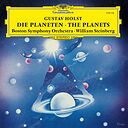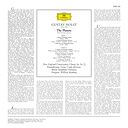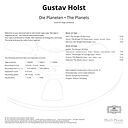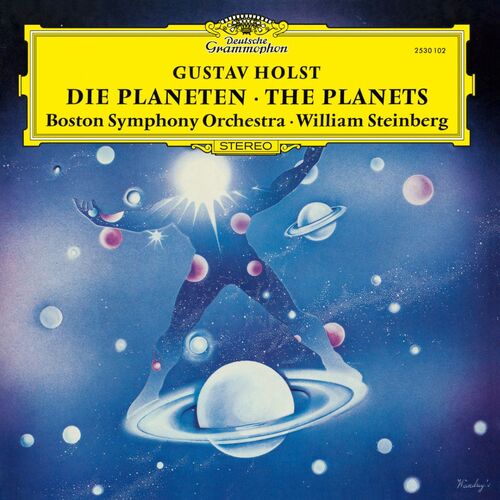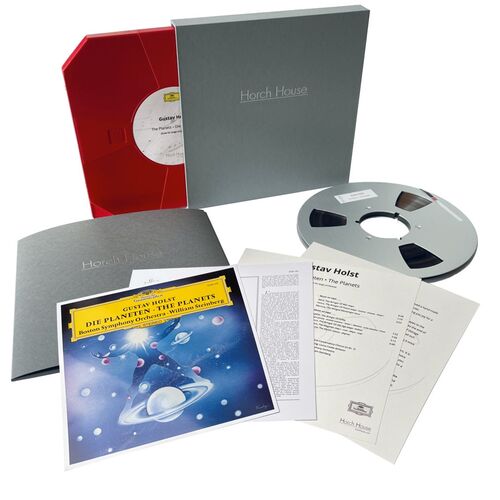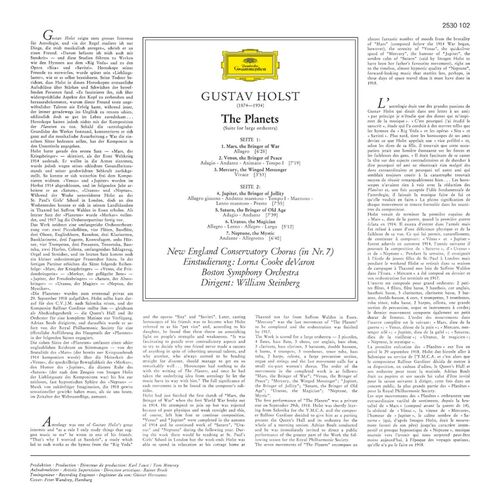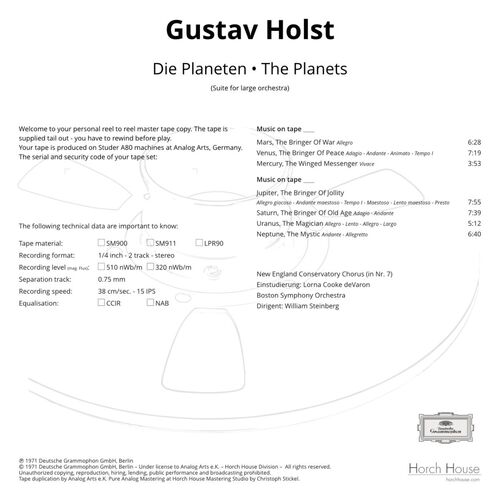William Steinberg & Boston Symphony Orchestra Gustav Holst: The Planets Master Quality Reel To Reel Tape (1 Reel)
- Бренд
- HORCH HOUSE
- Артикул
- HH05.00.40
Master Quality Reel To Reel Tape!
Studio Master Copy with 1 Metal Reel!
"The Planets", Op.32, is a seven-movement orchestral suite by the English composer Gustav Holst, each named after a planet and its corresponding astrological character, written between 1914 and 1916. Each movement of the suite is named after a planet of the Solar System and its corresponding astrological character as defined by Holst. With the exception of Earth, which is not observed in astrological practice, all the planets are represented.
The idea of the work was suggested to Holst by Clifford Bax, who introduced him to astrology when the two were part of a small group of English artists holidaying in Majorca in the spring of 1913; Holst became quite a devotee of the subject, and liked to cast his friends' horoscopes for fun.
Gustav Holst's seven-movement orchestral suite "The Planets" is a masterpiece of late Romantic program music, which is known to every classical music connoisseur, but also to many film fans. Each movement of the suite, composed between 1914 and 1916, is named after a planet of the solar system and the corresponding astrological sign that Holst defined. With the exception of Earth, which is not observed in astrological practice, all planets are represented.
The analogue recordings were the foundation for Christoph Stickel's subtle "refurbishing". The aim was in no way to interfere artificially. The recordings were merely "rid of noise".
The analogue recordings formed the basis for the subtle processing by the Grammy-nominated mastering professional Christoph Stickel, in which only "denoise" was carried out.
"Steinberg creates great excitement in 'Jupiter' and elsewhere, and his orchestra is on its toes throughout." - Record Review / David Mellor, Classic FM (London)/01. April 2004
"Holst's 'The Planets' gets a well-considered reading . . . The orchestral playing is superb . . ." - Record Review / Peter Joelson, Audiophile Audition/14. June 2012
WHAT EXACTLY IS AN 'ORIGINAL MASTER TAPE'?
Good question. The term is sometimes misused or misinterpreted, so it's worth getting clear on what's what. When an album is recorded, whether in the studio or on stage, it will either be a multi-track recording using several microphones and/or different sessions to record each individual element separately (instruments, vocals), or a live or semi-live recording in which one or several microphones capture the performance as a whole. The recording engineers will then bring the various elements together, editing and mixing them to achieve the desired sound and to remove unwanted noise, culminating in the album's first final arrangement. This is the original studio master tape, of which there will be not just one, but several: each of these is considered an 'original master'.
This original master is then used as the 'blueprint' for all subsequent copies, pressings, remasterings, etc. But of course with each subsequent treatment, something of the original information and hence sound quality is lost. Which is why nothing sounds quite like the original studio master tape. It's the original source of the album in its completed state.
DOES HORCH HOUSE DO ANY KIND OF REMASTERING DURING THE COPYING PROCESS?
Absolutely not! Why mess with the best? The whole point of what they do lies in capturing the magic of the original analogue master tape in its purest, most faithful form possible.
'Remastering' can be compared to using computer software to edit an original photograph. The benefits are that you can remove unwanted marks or noise, clean things up, remove distortion and boost clarity. The downside is that in doing so, you often lose the natural essence of the original and the result can seem rather synthetic, lacking in real life character.
The unfortunate fact is that tapes, like photographs, do tend to age over time, and most analogue masters are now between 30-80+ years old.
So Horch House undertake a painstaking 'soft refurbishing' process, which is key to recapturing the original quality of a master tape.
CAPTURING THE MAGIC OF MASTER TAPE
How exactly does Horch House translate an original analogue master tape into faithful copies on reel-to-reel tape and vinyl records?
They use a process that's been meticulously researched and developed by their expert team of sound engineers, with input from some of the world's leading specialists.
The first step is to carefully assess the sound quality of the original master tape, which their experts do in great detail. The unfortunate fact is that tapes do tend to age over time, and most analogue masters are now between 30-80+ years old. What they're looking to do, therefore, as an integral part of their copying process, is to restore the sound quality back to its original level. They want you to hear exactly what the first sound engineers heard (and indeed the musicians themselves), on the day that the original recording was made. This is in stark contrast to any kind of 'remastering', which they most definitely do not do! They're not looking to 'improve' the recording in any way, but rather to return it as closely as possible to its full original beauty.
They call this their 'soft refurbishing' process.
HOW CLOSE ARE HORCH HOUSE COPIES TO THE ORIGINAL MASTER TAPES?
Horch House believe that they're as close as it's possible to get - not simply to the master tape in its current condition, but to that master tape's original condition. Thanks to their detailed 'soft refurbishing' process, their master tape copies could, in a sense, now be considered as better than the current originals because they've been lovingly restored to deliver the same sound quality that the originals had on the day they were first recorded.
WHAT ABOUT COPYRIGHT? ARE MASTER TAPE COPIES LEGAL?
All Horch House master tape copies are fully authorized, licensed and approved by the relevant record label/music publisher.
The label HORCH HOUSE from Germany has stood for purely analogue sound enjoyment for 10 years and has specialized in tapes. We work exclusively with historical and new analogue tapes, which are carefully restored on analogue equipment at csmastering in Vienna if necessary. The tape copies are produced manually on meticulously maintained machines from Studer. The catalogue contains titles from the genres of classical, jazz, blues, rock/pop and easy listening. The packaging is appropriately stable for the medium, of high quality and excellently transportable and archivable.
** It is standard practice in all recording studios to keep the tape "tail out". This reduces "pre-echo" and it means that the tape should be placed on the right hand side of the recorder, re-wound and then played.
Features:
- Studio Master Copy
- 1-Reel Tape
- Label: Deutsche Grammophon
- Tape Material: RTM LPR90
- Recording Speed: 15IPS-38cm/sec
- Rec. Level (mag flux): 320 nWb/m
- Equalization: CCIR
- Bandwidth & Tracks: 1/4" - 2 Track
- Reel: Metal spool - 10.5" - 26,5 cm
- Production on Studer Machines Refurbished to Factory Specification
- Handmade
- Recorded in the private studio of Hans Georg Brunner-Schwer
- Recording director & engineer: Hans Georg Brunner-Schwer
- Fully Authorized, Licensed & Approved by the Record Label/Music Publisher
- Horch House Deluxe Packaging
Musicians:
- Boston Symphony Orchestra
- William Steinberg, conductor
- New England Conservatory Chorus (in Nr.7)
- Lorna Cooke deVaron, director
Selections:
Gustav Holst (1874-1934)
The Planets
1. Mars, The Bringer of War (1914)
2. Venus, the Bringer of Peace (1914)
3. Mercury, the Winged Messenger (1916)
4. Jupiter, the Bringer of Jollity (1914)
5. Saturn, the Bringer of Old Age (1915)
6. Uranus, the Magician (1915)
7. Neptune, the Mystic (1915)

